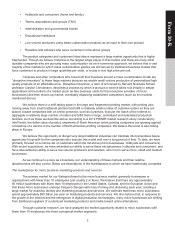Vistaprint 2015 Annual Report Download - page 21
Download and view the complete annual report
Please find page 21 of the 2015 Vistaprint annual report below. You can navigate through the pages in the report by either clicking on the pages listed below, or by using the keyword search tool below to find specific information within the annual report.
13
We manage our business for long-term results, and our quarterly financial results, especially our GAAP
results, will often fluctuate, which may lead to volatility in our share price.
Our revenues and operating results often vary significantly from quarter to quarter due to a number of
factors, and as a result comparing our financial results on a period-to-period basis may not be meaningful. Many of
the factors that lead to period-to-period fluctuations are outside of our control; however, some factors are inherent in
our business strategies. Additionally, we prioritize longer-term results over shorter-term results and generally do not
manage our business to maximize current period GAAP profitability metrics. Some of the specific factors that could
cause our operating results to fluctuate include among others:
• seasonality-driven or other variations in the demand for our products and services, in particular during
our second fiscal quarter;
• currency and interest rate fluctuations, which affect our revenues, costs, and fair value of our assets;
• our hedging activity;
• our ability to attract visitors to our websites and convert those visitors into customers;
• our ability to retain customers and generate repeat purchases;
• shifts in product mix toward less profitable products;
• the commencement or termination of agreements with our strategic partners, suppliers, and others;
• our ability to manage our production, fulfillment, and support operations;
• costs to produce and deliver our products and provide our services, including the effects of inflation;
• our pricing and marketing strategies and those of our competitors;
• investments in our business in the current period intended to generate or support revenues and
operations in future periods;
• expenses and charges related to our compensation agreements with our executives and employees;
• costs and charges resulting from litigation;
• significant increases in credits, beyond our estimated allowances, for customers who are not satisfied
with our products;
• changes in our income tax rate;
• costs to acquire businesses or integrate our acquired businesses;
• impairments of our tangible and intangible assets including goodwill; and
• the results of our minority investments and joint ventures.
Some of our expenses, such as office leases, depreciation related to previously acquired property and
equipment, and personnel costs, are relatively fixed, and we may be unable to, or may not choose to, adjust
operating expenses to offset any revenue shortfall. Accordingly, any shortfall in revenue may cause significant
variation in operating results in any quarter. Our operating results may sometimes be below the expectations of
public market analysts and investors, in which case the price of our ordinary shares will likely decline.
Form 10-K
























